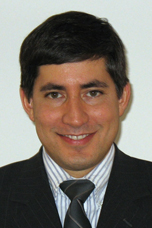Andrew E. Arai, M.D.
To arrange an interview, please contact the NHLBI Communications Office at 301-496-4236 or nhlbi_news@nhlbi.nih.gov.
Biography
Andrew E. Arai, M.D., F.A.H.A. joined the National Heart, Lung, and Blood Institute (NHLBI) in 1993. He is Chief of the Cardiovascular and Pulmonary Branch in the Institute's Division of Intramural Research. Dr. Arai is also the President of the Society of Cardiovascular Magnetic Resonance, the leading international professional organization focused on this new diagnostic technique.Dr. Arai’s research focuses on coronary artery disease, heart attack, and other diseases that affect the heart or blood vessels. His expertise is in the use of magnetic resonance imaging (MRI) to evaluate patients.
Dr. Arai focuses his research on understanding and intervening in this process of myocardial infarction and ischemia. His laboratory currently encompasses six major areas of clinical activity and translational research: 1) assessment of the area at risk from myocardial infarction, and myocardial salvage, 2) quantification of myocardial perfusion by magnetic resonance imaging (MRI), 3) technical development of diagnostic cardiovascular MRI, 4) anatomical and physiological evaluation of coronary artery disease by cardiovascular computed tomography (CT), 5) support for the NHLBI Advanced Cardiovascular Imaging Fellowship, and 6) clinical and research support for cardiovascular MRI and cardiovascular CT at the NIH Clinical Center in Bethesda, MD and at the Johns Hopkins Suburban Hospital in Bethesda, MD.
Dr. Arai received his MD from the University of Illinois College of Medicine, Chicago in 1986. He received his BA from Cornell University in Ithaca, NY in 1982. He completed a residency in Internal Medicine and a Cardiology fellowship at the Oregon Health Sciences University in 1989 and 1993 respectfully. In 2001, he received a Presidential Early Career Award for Scientists and Engineers. He has authored or coauthored over 130 papers or book chapters. He is a member of the American Society of Clinical Investigation. He is a fellow in the American Heart Association. He has been President of the Cardiac MRI Study Group for the International Society of Magnetic Resonance in Medicine. As a member of the American Heart Association Council on Clinical Cardiology, Committee on Cardiac Imaging, he has helped develop various scientific advisory papers on cardiac imaging. He has also served as an expert advisor to the US Food and Drug Administration. He directs a fellowship program training cardiologists and radiologists how to use cardiac MRI and cardiac CT to diagnose.
Dr. Arai In the News
September 10, 2012
: Science News
MRI spots silent heart attacks
Nathan Seppa
Many people have had a heart attack and don’t know it. A study of older people in Iceland finds that nearly twice as many had experienced a silent heart attack as had suffered one with all the medical bells and whistles. MRI scans revealed the hidden heart attacks better than standard testing by electrocardiography, or EKG, scientists report in the Sept. 5 Journal of the American Medical Association.
September 5, 2012
: Journal of the American Medical Association
Prevalence and Prognosis of Unrecognized Myocardial Infarction Determined by Cardiac Magnetic Resonance in Older Adults
co-authored by Peter Kellman, Ph.D., Anthony H. Aletras, Ph.D., and Andrew E. Arai, M.D. of the NHLBI Division of Intramural Research
In a community based cohort of oler individuals, the prevalence of unrecognized myocardial infarction by cardiac magnetic resonance imaging was higher than the prevalence of recognized myocardial infarction and was associated with increased mortality risk. In contrast, UMI by electrocardiography was lower than that of RMI and not associated with increased mortality risk.
View all Dr. Arai in the news articles















